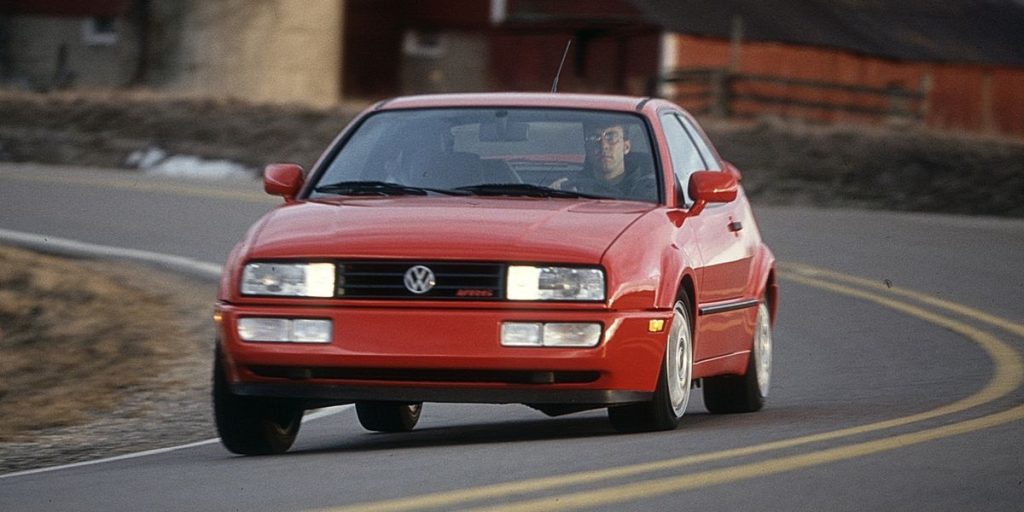From the Archive: 1993 Volkswagen Corrado SLC Tested

From the June 1992 issue of Car and Driver.
It’s alive! The Corrado has been gifted with life anew. VW’s pocket GT comes to us revitalized by a heart transplant, dramatically upgraded with a V-6 engine.
Designated SLC, for “Sports Luxury Coupe,” the latest Corrado blazes out of the Karmann coachworks, VW’s subcontractor, as a world-class runner from nose to tailpipe. In its pug nose, a free-revving, normally aspirated V-6 sends wholly unexpected power to the front wheels and passes rich sounds back to its outsize exhaust. The previous G60 Corrado buzzed with an overwrought, supercharged four-banger and languished in showrooms. (VW will keep the G60 on sale until it disposes of the 1500 still in stock; meantime, it will begin selling 3500 SLCs targeted for the U.S. during 1992).
The blunt G60 had been in need of a new heart for three years, ever since the pointy Diamond-Star coupes appeared. The result of a venture between Mitsubishi and Chrysler, the turbocharged, all-wheel-drive Eagle Talon (and the near-identical Plymouth Laser and Mitsubishi Eclipse) relegated the less-inspiring G60 to a fifth-place tie with the Ford Probe GT in a field of eight “Fired-Up Fours” (C/D, April).
The SLC now threatens to trounce the class. Look at its basic performance: 0 to 60 mph in 6.4 seconds, the quarter-mile in 15.0 second at 94 mph, and top speed of 141 mph. In short, this Corrado’s talent for speed makes it Germany’s wiseacre speedenheimer of pocket GTs (see sidebar below). It handily outstrips the best of the rest—the Talon/Laser/Eclipse all-wheel-drive turbos—and flat leaves the old Corrado for dead. The higher the speeds climb, the greater the new Corrado’s advantage.
HIGHS: Terrific performance, seats, sounds, and packaging.
What this doesn’t relay is the engine’s delight in dishing it out, and that begins from deep within. The 1.8-liter fourbanger with supercharger produced 158 hp at 5600 rpm and plenty of cacophonous sturm und drang to go with it, like the back-strasse bleatings of an overage oompah band. The normally aspirated 2.8-liter V-6 in the new Corrado develops 178 hp at 5800 rpm, plus an ecstatic accompaniment that sounds as if it came from the depths and heights of a great symphony orchestra with a feel for pops. It makes you feel as if you’ve tapped into a F1 engine. The four-banger churned out 166 pound-feet of torque at 4000 rpm, whereas the six whirs out 177 pound-feet at 4200 rpm. That may not look like much difference on paper, but out there on pavement, the V-6’s mercuric response allows you to level steep hills a gear or two higher than normal, even to gain rushes of speed in the face of gravity suddenly rendered inconsequential. The Corrado also laterally leapfrogs traffic about as quickly as a frog can snap flies out of midair. Response that feels this snappy in high-gear passing means lightning-like overtaking if you downshift the five-speed a gear or two. (Volkswagen also offers an optional electronically controlled four-speed automatic transmission for an extra $795—a bundle for a unit that’s sure to sap the Corrado’s newfound performance and yeeeeeeehawww! feel, which come “free” at the base price.)
The engine does more than run fast and freely. It looks terrific sitting sideways in the power bay under the seashell fanning of its astounding intake runners, and a deeper look reveals the engineering insight that’s gone into it. Volkswagen’s thinking began with a tight idea of what it was after—an extremely narrow V-type engine to allow the use of a single cylinder head, to provide narrow width for packaging and weight distribution, and to deliver exceptionally smooth running characteristics. VW dubs the engine the VR-6, with the “V” representing the configuration and the “R” standing for the German word Reihenmotor; together, VW says, they roughly mean “in-line vee.” This may sound like an engineering impossibility, but VW specified a single overhead cam for each bank of cylinders and only two valves per cylinder. Then the six’s V-angle was squeezed together very tightly—only 15 degrees, whereas common V-6s are designed as bulkier 60- or 90-degree layouts. Thus, Volkswagen’s V-6 can also be fitted (albeit with less power) to Passats, Jettas, and Golfs originally designed only for four-cylinders. Taking up less room than most of its ilk, the six provides added crush space for crashes. Despite the six’s extra cylinders, displacement, and performance, the SLC’s front/rear weight distribution of 60.9/39.1 betters the G60’s 63.6/36.4 distribution.
LOWS: Dash and body buzzes.
The downside: The SLC weighs 2837 pounds, versus the G60’s 2640 pounds. Blame part of the SLC’s gain on heftier running gear and a fuel tank enlarged to hold 18.5 gallons instead of 14.5. This easily offsets the thirstier six’s effect on cruising range. (The EPA city rating of 20 mpg for the previous model now drops to 18 mpg; despite storming around as fiercely as the six encouraged us to, we managed 20 mpg overall.) The final practical drawback to the SLC is that its bigger tank cuts trunk space from 19 cubic feet to 15—a small loss, as the Talon’s trunk measures a scant 8 cubic feet.
Larry Griffin|Car and Driver
Overall, whatever you think of its chunkiness—which suggests an updated Scirocco with lots of gym time—the Corrado’s basic packaging borders on brilliant. Its space efficiency shares the tradition evident in the neatly apportioned roominess of VW’s futuristic Passat. Once you lever in over the big bolsters of the Corrado’s velour sport seats, you find plenty of room. VW rightly supposes that a car as fast and agile as the SLC is bought more for driving in than clambering in and out of, and thus deserves solid Recaro-like shaping in its seats. They deliver support for backroad bulleting or long-distance driving. The lint-magnet seats hold you so well that you almost forget the lax tensioning of the motorized shoulder harnesses up front. VW’s split rear seats, unlike those in most pocket GTs, amount to more than watch pockets. Rear passengers who stand six feet or less can sit (upright, even) for 100 miles or more without losing legs due to circulatory blockage. The only pinching the driver perceives is the intrusion of the roof pillars and the motorized rear wing on outward visibility. They make you feel as if you’ve been thrown in San Quentin solitary.
VW sneaks in plenty of standard equipment to keep all the perps making time in its SLCs contented: power everything, a premium sound system that sounds far better than VW systems of yore, central locking with one-touch-down windows that also close when the key locks the door, a trip computer, intermittent wipers (programmable over a range of 1.5 to 22 seconds), a rear washer/wiper, an antitheft alarm, and leather covering for the steering wheel and shift knob. There are also a few exterior trim changes: a hood bulge, a reduction from seven grille bars to four, clear turn-signal lenses, and convex BBS wheels mounted by five bolts instead of four.
VW changed the transmission’s gear ratios to suit the new engine, replaced the G60’s vague cable-shift mechanism (praise be!) with precise mechanical linkage, and fitted an electronic limited-slip feature that only comes into play on tirespinning launches. The chassis engineers revised the suspension geometry and tuning to suit the added performance and weight, yet noticeably improved the ride despite wider wheels and tires, bringing the Corrado’s road manners more in line with the new sophistication shown by the powertrain (with the exception of a weak first-gear synchro).
The SLC steers with the lightfooted ease that comes from premium engineering and clings to the skidpad right up to 0.84 g. On the road, bumps and pokes of power move it around more than we’d ultimately like. But for a car that runs like Jack the Griz yet rides well, it rarely unsettles itself. It possesses that reassuring German trait we used to call “speed feel.” Its standard ABS brakes stop it from 70 mph in only 175 feet and show little fade even when snubbed hard from much higher speeds.
VERDICT: A transformation and a hellacious delight.
VW may also offer the V-6 in a lighter, simpler Club Sport Corrado for less money. Our base SLC lists for $22,210, so it runs only $950 more than a comparably equipped yet clearly more pedestrian G60—as in the difference between walking and running. A comparable Talon costs about $20,500, so it’ll undercut the Corrado by about $1700 … a factor right up until the Corrado leaves it sucking exhaust sufficiently toasty to Fahrverg your nugens.
Counterpoint
Here’s the best news for Volkswagen fans since the debut of the original GTI. The new six has transformed the Corrado in an amazing way. Around our test-car sign-out board, what was once “a pretty nice car but” is now “a really, really nice car and I’m taking it home tonight no matter how much you beg me, so let go of my leg.”
The SLC is a Corrado without rough edges. The six-cylinder engine is potent and sweet—the power delivery is so smooth and effortless you’d swear the throttle was a speed rheostat. The gearbox’s action is now fluid and positive. And the chassis, excellent from the start, feels even better now that it’s not playing against the incessant drone of the G60’s supercharger.
Add the Corrado’s distinctive shape—which I’ve always liked—and you have a sports coupe that does just about everything right. The price is a little steep, as it’s always been, but at last the Corrado feels like a car worth paying something extra for. —Arthur St. Antoine
Think BMW hatchback. Think reliable Alfa GTV6. Don’t think buzzy overpriced VW with boost lag. On a car that used to trade primarily on its styling, rarity, and Teutonic bank-vault body quality, Volkswagen is finally offering the ultimate sales incentive: 178 thoroughbred racehorses under the hood. The refinement, the performance, and—yes—the price of the quirky, low-volume Corrado are up for 1993, but the $22,210 SLC is a far better bargain than the $20,230 G60 model it replaces.
The torquey VR-6 will bark its meaty tires on aggressive first-to-second upshifts and pull strongly to redline in all five gears, singing a Mozart aria all the way. Cruising at 75 mph in fifth, the engine turns a quiet 3500 rpm, from which the SLC accelerates briskly without downshifting to fourth. These characteristics are as rare among its hot-hatch competition as are the Corrado’s adult-sized rear seat and decent luggage compartment. Despite its many strong suits, rarity is likely to remain one of Corrado’s selling points. Fine. So think German Mustang SVO. —Frank Markus
Well, Volkswagen is finally back. And with a vengeance. Not since an NSX was parked in the Hogback Road lot have so many staffers pushed and shoved to get in line for the keys. Saying it goes from 0 to 60 in 6.4 seconds doesn’t in the least describe the sensation of this little red hellion—it’s like saying Van Gogh could paint. Through the gears, its tires chirp in first. In second. In third. And despite all the screwball power from its scorching V-6, it is well grounded, feels solid as a brick, and does not stutter and shudder like some other pocket rockets. The suspension is as stiff as a washboard, as it should be. Styling is apropos of its fierce performance: the car seems to lean forward in the stance of a pit bull poised to pounce. The paint job is Porsche-quality. If there’s a shortcoming, it involves the seats and ergonomics; they remind us of the Scirocco’s somehow ungainly setup for long-legged folks. Getting out is awkward. But getting in is well worth it. —Steve Spence
VW Corrado SLC vs. Eagle Talon TSi AWD
The 0-to-120 times got us: the hot VW, by a dozen seconds, kicks Talon and takes names. The Eagle won our April comparison of “Fired-Up Fours,” but suddenly the 4wd turbo and its Plymouth and Mitsubishi counterparts are no longer the fastest diet-size two-plus-twos. The new 178-hp Corrado beats the 195-hp Talon in every speed test but one. And at only 2837 pounds, it weighs 343 pounds less than the Eagle. But there’s more to territorial takeovers than high speed and light weight.
Styling: The Corrado dresses for dinner but wears the burly-herdsman look. The Talon bulges a bit but still looks to be a bullet Advantage: Talon.
Interior: Both are businesslike, but the Talon’s wheel is more likely to hide the gauges. And the Corrado’s dandy seats grasp you much better for hard drives and cruises alike. Advantage: Corrado.
Packaging: The Corrado is roomy, even okay in back for adults if you’re not off to Pluto (and the big trunk helps). The Talon’s puckered rear seating feels as if it sucked lemons. Advantage: Corrado.
Visibility: The Talon may not be open and airy, but the Corrado’s looming roof pillars and rear wing give you a more closed-off feeling. Advantage: Talon.
Controls: The Corrado offers fine shifting, steering, pedal feel, and natural reaches, although you’d have to crowbar the pedals to ease heel-and-toe downshifts (grownups, don’t try this at home). The Talon’s cable shifter clonks. Advantage: Corrado.
Structure: The Corrado gets VW’s normal allotment of dashboard and body buzzes. The Talon feels tighter, but you won’t mistake either for a Benz. Advantage: Talon.
Engine: The Talon’s turbo pulls with a vengeance but kicks up a fuss about it. The Corrado’s slick new engine proves that a magic six can beat a turbo four-banger on almost all terms. Advantage: Corrado.
Acceleration: However you hammer it, the Corrado puts the motor on the Talon. This VW lives to run. Advantage: Corrado.
Braking: Unless bumps upset it, the Corrado stops more easily on all but very slick surfaces. There the Talon’s four-wheel drive provides added stability. Advantage: Corrado.
Handling: Your choice of feel—feathery Corrado or Talon heft. You’ll probably drive well in either. The VW carves into corners more gladly, but the Eagle often exits more surely. Advantage: Tie.
Marathoning: The Corrado gives comfort, good tracking, a resolute cruise control, and huge distances per fueling, thanks to a big gas tank. The Talon travels well, too, despite its ever-droning exhaust. And it’s got cupholders. Advantage: Tie.
Linescore: Corrado 8, Talon 5
Not to fudge, but such a tally doesn’t necessarily represent the essence of an outcome. The Talon and the Corrado appeal to us equally. The VW feels livelier, handier, friendlier. Yet we can’t fault the Eagle’s sportiness, heartiness, and four-wheel drive. You could almost let your climate be your guide.

Car and Driver
Specifications
Specifications
1993 Volkswagen Corrado SLC
Vehicle Type: front-engine, front-wheel-drive, 4-passenger, 2-door hatchback
PRICE
As Tested: $22,210
ENGINE
DOHC 24-valve 2.8-liter V-6, iron block and aluminum head, port fuel injection
Displacement: 170 in3, 2792 cm3
Power: 178 hp @ 5800 rpm
Torque: 177 lb-ft @ 4200 rpm
TRANSMISSION
5-speed manual
CHASSIS
Suspension, F/R: struts/torsion beam
Brakes, F/R: 11.0-in vented disc/8.9-in disc
Tires: Continental Sport Contact
205/50VR-15
DIMENSIONS
Wheelbase: 97.3 in
Length: 159.4 in
Width: 65.9 in
Height: 51.9 in
Passenger Volume, F/R: 48/32 ft3
Cargo Volume: 15 ft3
Curb Weight: 2837 lb
C/D TEST RESULTS
60 mph: 6.4 sec
100 mph: 17.2 sec
1/4-Mile: 15.0 sec @ 94 mph
130 mph: 42.6 sec
Rolling Start, 5–60 mph: 6.7 sec
Top Gear, 30–50 mph: 8.3 sec
Top Gear, 50–70 mph: 8.4 sec
Top Speed (mfr’s claim): 141 mph
Braking, 70–0 mph: 175 ft
Roadholding, 300-ft Skidpad: 0.84 g
C/D FUEL ECONOMY
Observed: 20 mpg
EPA FUEL ECONOMY
Combined/City/Highway: 19/16/23 mpg
C/D TESTING EXPLAINED
This content is imported from OpenWeb. You may be able to find the same content in another format, or you may be able to find more information, at their web site.







